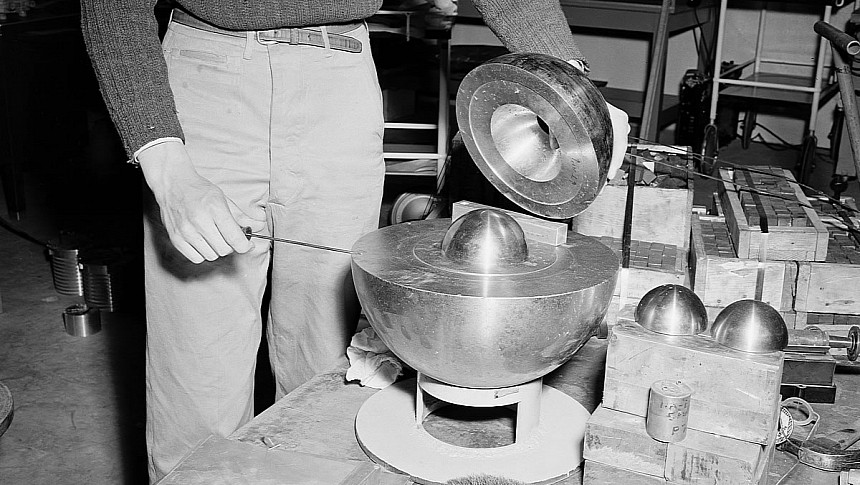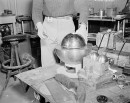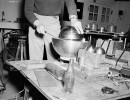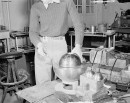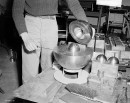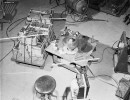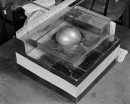"I can not let you escape, Squidward. I'm adding another demon core to your confinement until you calm down." This short but simple one-liner viral meme's made for a few laughs recently. There's something about the juxtaposition of two beloved cartoon characters, SpongeBob and Squidward, messing with one of the most notorious nuclear accidents in history that just works comedically. Maybe only the passage of time has allowed a layer of humor to be built around a nuclear mishap that was anything but funny.
But then again, the fact a catastrophically awry nuclear experiment from nearly eight decades ago became the subject of a meme in 2023 speaks to the unexpected perils that younger generations never expected to face. But what even is a demon core? Well, provocative nicknames aside, all it was in principle was a 14-ish lb (6.2 kg) mass of sub-critical fissile plutonium isotope approximately 3.5 inches (89 mm) in diameter. In this form, the demon core could have easily been the foundation for groundbreaking early experiments in nuclear energy generation for commercial service.
But instead, the demon core served a far more sinister purpose. As a test bed for the novel implosion-type atomic bomb, the core is irreversibly tied to the Manhattan Project that thrust the world kicking and screaming into the atomic age, whether or not the people at large were ready. Like the Fat Man atomic weapon dropped over Nagasaki, the demon core was designed not outright explode like gun-type nukes of the day. Rather, such devices were designed to implode so spontaneously through inward-directed internal detonations that an out-of-control supercritical fission reaction was formed.
In its most basic principles, the Demon consisted of three pieces. Two half-spheres of sub-critical plutonium-gallium alloy metal joined together by a metallic ring which regulated the flow of fissile neutrons between the two half-spheres. Compared to the nuclear core used during the Trinity test, the world's first atomic weapon detonation, the only difference between the two devices is the lack of this moderating ring.
Of course, the Trinity test's nuclear core, the demon core, and the first two atomic bombs used in combat were manufactured by the same Los Alamos Laboratory, chaired first by Robert Oppenheimer from mid-1943 to December 1945. When dropped over the unsuspecting Japanese city by a Boeing B-29 Superfortress called Bockscar, the results were nothing short of biblical. Never before had mankind experienced such concentrated destruction over a wide area in so little time, nor had they experienced the same gruesome casualties that atomic weapons are now notorious for inflicting.
Had Imperial Japan not capitulated after the second atomic bombing of Nagasaki, the Allied nations had every intention of selecting another Japanese city for nuclear bombardment using the demon core as its foundation. But upon the unconditional surrender of the Japanese, it was decided that the demon core was to remain on-site at Los Alamos Laboratory's facility just northwest of Santa Fe, New Mexico, for further experimentation. Unknowingly to the higher-ups at Los Alamos, this decision would one day cost American lives.
On August 21, 1945, just 11 days after Nagasaki was bombed, Los Alamos scientist Haroutune Krikor "Harry" Daghlian Jr of New London, Connecticut, was attempting to assemble a neutron reflector field around the demon core's proximity to lower the level of mass needed for the core to jump from a sub-critical to a critical state. Doing so by deflecting neutrons back onto the core rather than out into the atmosphere. This neutron reflector field consisted of several tungsten-carbide bricks and was assembled by Daghlian alone, with only one security guard beside himself in the room. Today, such an oversight would be seen as a massive safety violation.
But as Daghlian prepared to lower the final brick into place around the demon core, he dropped the piece, inadvertently sending it tumbling into the core itself and sending it into a state called prompt criticality. Daghlian rushed to partially disassemble the reflector field in a near-blind panic but received a colossal dose of radiation to the tune of 510 rem (5.1 Seiverts). Daghlian died 25 days later of acute radiation poisoning. Nine months later to the day on Mat 21st, 1946, a second fatal incident occurred.
This time, Los Alamos physicist, Canadian national, and Manhattan Project veteran Louis Slotin and seven colleagues were conducting experiments to determine the demon core's exact critical mass by surrounding the two plutonium-gallium hemispheres with two mirroring half-spheres of beryllium, a powerful neutron reflector. As Louis Slotin manipulated the two halves of the core with a screwdriver, the tool promptly slipped out of his hands, causing the two hemispheres to come into direct contact and trigger a powerful blast of ionizing radiation that reportedly made the air in the room glow a vibrant blue.
Like Harry Daghlian before him, Slottin subjected himself to even more radiation by knocking the upper half of the beryllium reflector to the ground with his bare hands. Slottin died nine days later from the same radiation sickness that killed his colleague less than a year earlier. Three more people in the room at the time of the incident also died of radiation-induced illnesses at various points after the accident. Amazingly, the demon core was slated for use in the nuclear explosion tests above Bikini Atoll during Operation Crossroads, even after the deaths of Slottin and Daghlian.
But while waiting for the deadly nuclear core to "cool down" to a lesser criticality state, it was decided that both halves of the device were to be melted down and its fissile material be used in new experimental fissile cores. So then, the demon core was clearly no laughing matter in spite of the viral memes depicting it in the 2020s. But as we alluded to earlier, it's the very fact nuclear experiments are in the zeitgeist of post-Cold War millennials and zoomers that's indicative of profound changes in modern society.
Indeed, it was the Cold War between the United States and the Soviet Union that became the impetus for continuing nuclear weapons research after the end of World War II. But for people born after the fall of the Berlin Wall, the common idea that nuclear annihilation is a peril that only their parents and grandparents had to ponder was still pervasive. But as the 2020s roll on and the threat of nuclear weapons being deployed in current conflicts and potential new ones in Ukraine and Taiwan, the notion that nuclear armageddon is somehow an issue for baby boomer and Gen-X-aged people is starting to look very questionable.
In an online space that often attempts to digest very serious and pivotal topics like nuclear war behind the humor of internet memes, is it any wonder the demon core is making a cultural comeback? The recent hit motion picture Oppenheimer, which details much of the work performed at Los Alamos during the Manhattan Project, could be seen as another lens through which to digest the potential horrors of nuclear accidents. Whatever the case, watching how a new generation comes to terms with the reality of what can happen during nuclear experiments is nothing short of fascinating to watch.
As the 80th anniversaries of the twin nuclear accidents involving the demon core come into view in 2025 and 2026, one can't help but find it curious how some of the same conditions that started the Manhattan Project still exist eight decades later. The only difference this time is that instead of the USSR at the other end of an admittedly not-black-and-white, hero-villain dynamic, it's the Russian Federation and China. As a young, upcoming generation comes to terms with the gravity of what's on the line if these nuclear powers go to war with one another, expect to see more memes with the demon core and nuclear accidents in general to continue to proliferate.
But instead, the demon core served a far more sinister purpose. As a test bed for the novel implosion-type atomic bomb, the core is irreversibly tied to the Manhattan Project that thrust the world kicking and screaming into the atomic age, whether or not the people at large were ready. Like the Fat Man atomic weapon dropped over Nagasaki, the demon core was designed not outright explode like gun-type nukes of the day. Rather, such devices were designed to implode so spontaneously through inward-directed internal detonations that an out-of-control supercritical fission reaction was formed.
In its most basic principles, the Demon consisted of three pieces. Two half-spheres of sub-critical plutonium-gallium alloy metal joined together by a metallic ring which regulated the flow of fissile neutrons between the two half-spheres. Compared to the nuclear core used during the Trinity test, the world's first atomic weapon detonation, the only difference between the two devices is the lack of this moderating ring.
Of course, the Trinity test's nuclear core, the demon core, and the first two atomic bombs used in combat were manufactured by the same Los Alamos Laboratory, chaired first by Robert Oppenheimer from mid-1943 to December 1945. When dropped over the unsuspecting Japanese city by a Boeing B-29 Superfortress called Bockscar, the results were nothing short of biblical. Never before had mankind experienced such concentrated destruction over a wide area in so little time, nor had they experienced the same gruesome casualties that atomic weapons are now notorious for inflicting.
On August 21, 1945, just 11 days after Nagasaki was bombed, Los Alamos scientist Haroutune Krikor "Harry" Daghlian Jr of New London, Connecticut, was attempting to assemble a neutron reflector field around the demon core's proximity to lower the level of mass needed for the core to jump from a sub-critical to a critical state. Doing so by deflecting neutrons back onto the core rather than out into the atmosphere. This neutron reflector field consisted of several tungsten-carbide bricks and was assembled by Daghlian alone, with only one security guard beside himself in the room. Today, such an oversight would be seen as a massive safety violation.
But as Daghlian prepared to lower the final brick into place around the demon core, he dropped the piece, inadvertently sending it tumbling into the core itself and sending it into a state called prompt criticality. Daghlian rushed to partially disassemble the reflector field in a near-blind panic but received a colossal dose of radiation to the tune of 510 rem (5.1 Seiverts). Daghlian died 25 days later of acute radiation poisoning. Nine months later to the day on Mat 21st, 1946, a second fatal incident occurred.
This time, Los Alamos physicist, Canadian national, and Manhattan Project veteran Louis Slotin and seven colleagues were conducting experiments to determine the demon core's exact critical mass by surrounding the two plutonium-gallium hemispheres with two mirroring half-spheres of beryllium, a powerful neutron reflector. As Louis Slotin manipulated the two halves of the core with a screwdriver, the tool promptly slipped out of his hands, causing the two hemispheres to come into direct contact and trigger a powerful blast of ionizing radiation that reportedly made the air in the room glow a vibrant blue.
But while waiting for the deadly nuclear core to "cool down" to a lesser criticality state, it was decided that both halves of the device were to be melted down and its fissile material be used in new experimental fissile cores. So then, the demon core was clearly no laughing matter in spite of the viral memes depicting it in the 2020s. But as we alluded to earlier, it's the very fact nuclear experiments are in the zeitgeist of post-Cold War millennials and zoomers that's indicative of profound changes in modern society.
Indeed, it was the Cold War between the United States and the Soviet Union that became the impetus for continuing nuclear weapons research after the end of World War II. But for people born after the fall of the Berlin Wall, the common idea that nuclear annihilation is a peril that only their parents and grandparents had to ponder was still pervasive. But as the 2020s roll on and the threat of nuclear weapons being deployed in current conflicts and potential new ones in Ukraine and Taiwan, the notion that nuclear armageddon is somehow an issue for baby boomer and Gen-X-aged people is starting to look very questionable.
In an online space that often attempts to digest very serious and pivotal topics like nuclear war behind the humor of internet memes, is it any wonder the demon core is making a cultural comeback? The recent hit motion picture Oppenheimer, which details much of the work performed at Los Alamos during the Manhattan Project, could be seen as another lens through which to digest the potential horrors of nuclear accidents. Whatever the case, watching how a new generation comes to terms with the reality of what can happen during nuclear experiments is nothing short of fascinating to watch.
